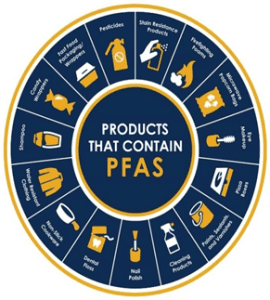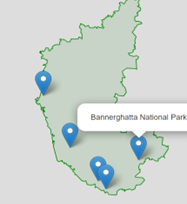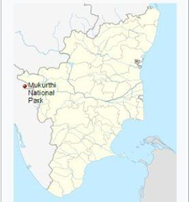Day-712
Quiz-summary
0 of 5 questions completed
Questions:
- 1
- 2
- 3
- 4
- 5
Information
DAILY MCQ
You have already completed the quiz before. Hence you can not start it again.
Quiz is loading...
You must sign in or sign up to start the quiz.
You have to finish following quiz, to start this quiz:
Results
0 of 5 questions answered correctly
Your time:
Time has elapsed
You have reached 0 of 0 points, (0)
Categories
- Not categorized 0%
- 1
- 2
- 3
- 4
- 5
- Answered
- Review
-
Question 1 of 5
1. Question
1. Consider the following statements:
Statement-I: The mountains lying within the tropics contain the highest biodiversity on the earth.
Statement-II: The more heterogeneous the geological composition of mountains is, the more biodiverse they are.
Which one of the following is correct in respect of the above statements?Correct
Answer. D
Explanation:
Statement I is incorrect but statement II is correct: Humboldt’s Enigma states that the earth’s tropical areas by themselves don’t contain all the biodiverse regions, that many areas outside the tropics are highly biodiverse. These places are mountains. Indeed, while we expect diversity to decrease away from the tropics, mountains have been an important exception.
A simple way to think of Humboldt’s enigma in India is to consider the biodiversity in our tropical areas, south of the Tropic of Cancer passing through Madhya Pradesh and Chhattisgarh. These areas are supposed to be the most diverse in the country. The Western Ghats plus Sri Lanka biodiversity hotspot lies in this zone. However, the eastern Himalayas are much more diverse.
Scientists have found that the more heterogeneous the geological composition of mountains is, the more biodiverse they are. Around the world, all mountains with high biodiversity have high geological heterogeneity as well, especially in the tropics.
Even in tropical regions, where we expect higher biodiversity, some mountains with a lower variety of rocks are relatively less biodiverse.
Mountains host two processes that generate biodiversity. First: geological processes, like uplifts, result in new habitats where new species arise, so the habitats are ‘cradles’. Second: species on some climatologically stable mountains persist there for a long time, so these spots are ‘museums’ that accumulate many such species over time.
Coastal tropical sky islands (mountains surrounded by lowlands), like the Shola Sky Islands in the Western Ghats, are a good example. Here, old lineages have persisted on the mountain tops as climates and habitats fluctuated around them in the lower elevations. This is the reason some of the oldest bird species in the Western Ghats, such as the Sholicola and the Montecincla, are housed on the Shola Sky Islands.Incorrect
Answer. D
Explanation:
Statement I is incorrect but statement II is correct: Humboldt’s Enigma states that the earth’s tropical areas by themselves don’t contain all the biodiverse regions, that many areas outside the tropics are highly biodiverse. These places are mountains. Indeed, while we expect diversity to decrease away from the tropics, mountains have been an important exception.
A simple way to think of Humboldt’s enigma in India is to consider the biodiversity in our tropical areas, south of the Tropic of Cancer passing through Madhya Pradesh and Chhattisgarh. These areas are supposed to be the most diverse in the country. The Western Ghats plus Sri Lanka biodiversity hotspot lies in this zone. However, the eastern Himalayas are much more diverse.
Scientists have found that the more heterogeneous the geological composition of mountains is, the more biodiverse they are. Around the world, all mountains with high biodiversity have high geological heterogeneity as well, especially in the tropics.
Even in tropical regions, where we expect higher biodiversity, some mountains with a lower variety of rocks are relatively less biodiverse.
Mountains host two processes that generate biodiversity. First: geological processes, like uplifts, result in new habitats where new species arise, so the habitats are ‘cradles’. Second: species on some climatologically stable mountains persist there for a long time, so these spots are ‘museums’ that accumulate many such species over time.
Coastal tropical sky islands (mountains surrounded by lowlands), like the Shola Sky Islands in the Western Ghats, are a good example. Here, old lineages have persisted on the mountain tops as climates and habitats fluctuated around them in the lower elevations. This is the reason some of the oldest bird species in the Western Ghats, such as the Sholicola and the Montecincla, are housed on the Shola Sky Islands. -
Question 2 of 5
2. Question
2. With reference to ‘Petersburg Climate Dialogue 2023’, consider the following statements:
1. It was co-hosted by the governments of Germany and United Arab Emirates in 2023.
2. It led to the launch of the Global Biofuels Alliance, as part of the Green Development Pact.
Which of the statements given above is/are correct?Correct
Answer. A
Statement 1 is correct: Ahead of the UNFCCC COP28, Petersburg Climate Dialogue 2023 was co-hosted by Germany and the United Arab Emirates (UAE) from May 2 to 3, 2023 in Berlin, Germany. Environment Ministers from 40 countries including India and USA attended the conference to discuss the way forward towards COP28.
Statement 2 is incorrect: Global Biofuels Alliance was launched under the Green Development Pact concluded at the G20 Summit 2023. ‘Acceleration Agenda’ as outcome of the climate dialogue pressed the need for fast-forwarding progress by countries on their Net Zero deadlines. The Agenda called for coal phaseout by 2030 in Organisation for Economic Co-operation and Development countries, and by 2040 in all others, as well as achieving Net Zero electricity generation and decarbonising major sectors.
Additional information:
The first Petersberg Climate Dialogue, aimed at improving communication between leaders and environmental ministers following the nearly unsuccessful negotiations at the 2009 United Nations Climate Change Conference in Copenhagen (COP15), was initiated by German politician and former German Chancellor Angela Merkel. The meeting took place on April 2–4, 2010 at Hotel Petersberg, located on the hill named “Petersburg” near the German city of Bonn, where the UNFCCC is headquartered. In subsequent years, the Petersberg Climate Dialogue conference was held in Berlin.Incorrect
Answer. A
Statement 1 is correct: Ahead of the UNFCCC COP28, Petersburg Climate Dialogue 2023 was co-hosted by Germany and the United Arab Emirates (UAE) from May 2 to 3, 2023 in Berlin, Germany. Environment Ministers from 40 countries including India and USA attended the conference to discuss the way forward towards COP28.
Statement 2 is incorrect: Global Biofuels Alliance was launched under the Green Development Pact concluded at the G20 Summit 2023. ‘Acceleration Agenda’ as outcome of the climate dialogue pressed the need for fast-forwarding progress by countries on their Net Zero deadlines. The Agenda called for coal phaseout by 2030 in Organisation for Economic Co-operation and Development countries, and by 2040 in all others, as well as achieving Net Zero electricity generation and decarbonising major sectors.
Additional information:
The first Petersberg Climate Dialogue, aimed at improving communication between leaders and environmental ministers following the nearly unsuccessful negotiations at the 2009 United Nations Climate Change Conference in Copenhagen (COP15), was initiated by German politician and former German Chancellor Angela Merkel. The meeting took place on April 2–4, 2010 at Hotel Petersberg, located on the hill named “Petersburg” near the German city of Bonn, where the UNFCCC is headquartered. In subsequent years, the Petersberg Climate Dialogue conference was held in Berlin. -
Question 3 of 5
3. Question
3. Consider the following:
1. Dental floss
2. Grease-resistant clothing
3. Microwave popcorn bags
4. Non-stick cookware
5. Bandages
In the making of how many of the above are ‘Per-and-polyfluoroalkyl substances’, also known as ‘Forever Chemicals’, used?Correct
Answer. D
Explanation:
PFAS (per- and polyfluoroalkyl substances) dubbed as ‘forever chemicals’ are endocrine-disrupting chemicals (EDCs).
PFAS are a vast family of synthetic chemicals found in everyday products such as non-stick cookware, upholstery, food packaging, water or stain resistant coatings, and industrial materials. These chemicals do not degrade easily in the environment.
PFAS chemicals help products resist heat, oil, stains, grease and water. These contaminants are persistent in the environment, and could lead to adverse health effects such as liver damage, low infant birth weights, hormonal imbalance, fertility issues, immune system effects, and even cancer.
Current methods to destroy PFAS require harsh treatments, such as incineration at extremely high temperatures or irradiating them with ultrasonic waves. However, incineration isn’t always foolproof.
PFAS’ indestructibility comes from their carbon-flouride bonds, one of the strongest types of bonds in organic chemistry.
 Incorrect
Incorrect
Answer. D
Explanation:
PFAS (per- and polyfluoroalkyl substances) dubbed as ‘forever chemicals’ are endocrine-disrupting chemicals (EDCs).
PFAS are a vast family of synthetic chemicals found in everyday products such as non-stick cookware, upholstery, food packaging, water or stain resistant coatings, and industrial materials. These chemicals do not degrade easily in the environment.
PFAS chemicals help products resist heat, oil, stains, grease and water. These contaminants are persistent in the environment, and could lead to adverse health effects such as liver damage, low infant birth weights, hormonal imbalance, fertility issues, immune system effects, and even cancer.
Current methods to destroy PFAS require harsh treatments, such as incineration at extremely high temperatures or irradiating them with ultrasonic waves. However, incineration isn’t always foolproof.
PFAS’ indestructibility comes from their carbon-flouride bonds, one of the strongest types of bonds in organic chemistry.

-
Question 4 of 5
4. Question
4. Consider the following:
1. Biosparging
2. Bio-reactor
3. Bio-piling
4. Bioventing
How many of the above-mentioned are examples of ex-situ methods of bioremediation?Correct
Answer. B
Explanation: Options 2 and 3 are correct.
Bioremediation refers to the process in which microorganisms/plants or more directly their metabolic enzymes/exudates are used as bio resources or acting agents to degrade or neutralize unnecessary materials/xenobiotics and convert them in to less toxic or more easily degradable forms.
IN-SITU BIOREMEDIATION TECHNIQUES
Biosparging involves application of air under pressure by the injections to develop the high oxygen levels that in turn can improve the rate of pollutants degradation.
Bioventing involves providing a very low flow oxygen to avoid unnecessary release of volatiles into the air by making an oxygen concentration just enough to sustain the microbes and degrade the pollutant and not any excess of oxygen. It often uses direct injection of oxygen with the help of wells into the soil and groundwater where the pollutants are present more dipping from the surface.
Bio-augmentation is a process in which an extra microbial augmentation or addition is required for bioremediation purposes. The introduction of a group of naturally indigenous/exogenous microbial strains or consortium or community or a genetically engineered variant is used in the augmentation process to solve contaminated soil or water pollution.
EX-SITU BIOREMEDIATION TECHNIQUES
A biopile is an ex situ treatment technology that leverages biological processes to convert contaminants to low-toxicity byproducts. Excavated soil or sediment is placed in piles onto an impermeable base or pad equipped with aeration to optimize and control the rate of biodegradation. Biopiles are soil amendments process along with forced aeration supplements.
Solid phase treatments are basically landfarming processes to facilitate the aerobic microbial degradation of pollutants by excavating the polluted soil from somewhere else. This excavated soil is subjected to place on the surface like a thin sheet or uniform bed like structure to gain a most possible contact between indigenous microorganisms with the xenobiotic and pollutants present in the excavated soil.
Bioreactors represent highly controlled methods of treating contaminated soils and groundwater. Because temperature, pH, nutrient levels, and agitation can be controlled in constructed batch- or continuously-fed reactors, microbial activity, and thus contaminant degradation, can be optimized.
Slurry-phase biological treatment is performed in a reactor to remediate a mixture of water and excavated soil. The soil is mixed with water to a concentration that is determined by the proportions of the contaminants in soils, the rate of biodegradation, and the physical nature of the soils. If the soil is prewashed, the contaminated fines and wash water are treated in the reactor. The slurry contains between 5 and 40% solids by weight depending on the nature of the biological reactor. The soil is suspended in a reactor vessel and mixed with nutrients and oxygen. Microorganisms, acid, or alkali may be added depending on treatment requirements. When biodegradation is complete, the soil slurry is dewatered.Incorrect
Answer. B
Explanation: Options 2 and 3 are correct.
Bioremediation refers to the process in which microorganisms/plants or more directly their metabolic enzymes/exudates are used as bio resources or acting agents to degrade or neutralize unnecessary materials/xenobiotics and convert them in to less toxic or more easily degradable forms.
IN-SITU BIOREMEDIATION TECHNIQUES
Biosparging involves application of air under pressure by the injections to develop the high oxygen levels that in turn can improve the rate of pollutants degradation.
Bioventing involves providing a very low flow oxygen to avoid unnecessary release of volatiles into the air by making an oxygen concentration just enough to sustain the microbes and degrade the pollutant and not any excess of oxygen. It often uses direct injection of oxygen with the help of wells into the soil and groundwater where the pollutants are present more dipping from the surface.
Bio-augmentation is a process in which an extra microbial augmentation or addition is required for bioremediation purposes. The introduction of a group of naturally indigenous/exogenous microbial strains or consortium or community or a genetically engineered variant is used in the augmentation process to solve contaminated soil or water pollution.
EX-SITU BIOREMEDIATION TECHNIQUES
A biopile is an ex situ treatment technology that leverages biological processes to convert contaminants to low-toxicity byproducts. Excavated soil or sediment is placed in piles onto an impermeable base or pad equipped with aeration to optimize and control the rate of biodegradation. Biopiles are soil amendments process along with forced aeration supplements.
Solid phase treatments are basically landfarming processes to facilitate the aerobic microbial degradation of pollutants by excavating the polluted soil from somewhere else. This excavated soil is subjected to place on the surface like a thin sheet or uniform bed like structure to gain a most possible contact between indigenous microorganisms with the xenobiotic and pollutants present in the excavated soil.
Bioreactors represent highly controlled methods of treating contaminated soils and groundwater. Because temperature, pH, nutrient levels, and agitation can be controlled in constructed batch- or continuously-fed reactors, microbial activity, and thus contaminant degradation, can be optimized.
Slurry-phase biological treatment is performed in a reactor to remediate a mixture of water and excavated soil. The soil is mixed with water to a concentration that is determined by the proportions of the contaminants in soils, the rate of biodegradation, and the physical nature of the soils. If the soil is prewashed, the contaminated fines and wash water are treated in the reactor. The slurry contains between 5 and 40% solids by weight depending on the nature of the biological reactor. The soil is suspended in a reactor vessel and mixed with nutrients and oxygen. Microorganisms, acid, or alkali may be added depending on treatment requirements. When biodegradation is complete, the soil slurry is dewatered. -
Question 5 of 5
5. Question
5. Consider the following pairs:
List I – List II
(National Parks) – (Associated geographical features)
1. Kaziranga National Park – Burapahar range
2. Bannerghatta National Park – Anekal range
3. Mukurthi National Park – Kolaribetta peak
How many of the above pairs are correctly matched?Correct
Answer. C
Explanation: Options 1, 2 and 3 are correct.
KAZIRANGA NATIONAL PARK

Location: in the Golaghat and Nagaon regions of Assam
Geographical features:
● Brahmaputra River on the North
● the Karbi Anglong mountains on the South
● 4 ranges in it: the Agoratoli range on the Eastern part, Kohora range covering the central part, Baguri range in the western part and Burapahar range covering the additional area attached to the park.BANNERGHATTA NATIONAL PARK



Location: Bengaluru, Karnataka
Geographical features:
● It includes 10 reserve forests of Anekal range.
● Originating from the Suvarnamukhi hills, the Suvarnamukhi stream runs through the park to provide it with a good amount of water.
● The park has a hilly terrain of granite sheets under moist deciduous forest valleys and scrubland on higher areas.
Note:
India’s first Butterfly Park was established at the Bannerghatta Biological ParkMUKURTHI NATIONAL PARK



Location: Tamil Nadu
Geographical features:
● The Kollaribetta and the Nilgiri Peak are the major peaks around.
● The area is chained by innumerable beautiful and perennial little streams, which fall into Bhavani Puzha.
● The park is a part of the Nilgiri Biosphere Reserve.
● It is sandwiched between the Mudumalai National Park and the Silent Valley National Park.Incorrect
Answer. C
Explanation: Options 1, 2 and 3 are correct.
KAZIRANGA NATIONAL PARK



Location: in the Golaghat and Nagaon regions of Assam
Geographical features:
● Brahmaputra River on the North
● the Karbi Anglong mountains on the South
● 4 ranges in it: the Agoratoli range on the Eastern part, Kohora range covering the central part, Baguri range in the western part and Burapahar range covering the additional area attached to the park.BANNERGHATTA NATIONAL PARK



Location: Bengaluru, Karnataka
Geographical features:
● It includes 10 reserve forests of Anekal range.
● Originating from the Suvarnamukhi hills, the Suvarnamukhi stream runs through the park to provide it with a good amount of water.
● The park has a hilly terrain of granite sheets under moist deciduous forest valleys and scrubland on higher areas.
Note:
India’s first Butterfly Park was established at the Bannerghatta Biological ParkMUKURTHI NATIONAL PARK



Location: Tamil Nadu
Geographical features:
● The Kollaribetta and the Nilgiri Peak are the major peaks around.
● The area is chained by innumerable beautiful and perennial little streams, which fall into Bhavani Puzha.
● The park is a part of the Nilgiri Biosphere Reserve.
● It is sandwiched between the Mudumalai National Park and the Silent Valley National Park.

